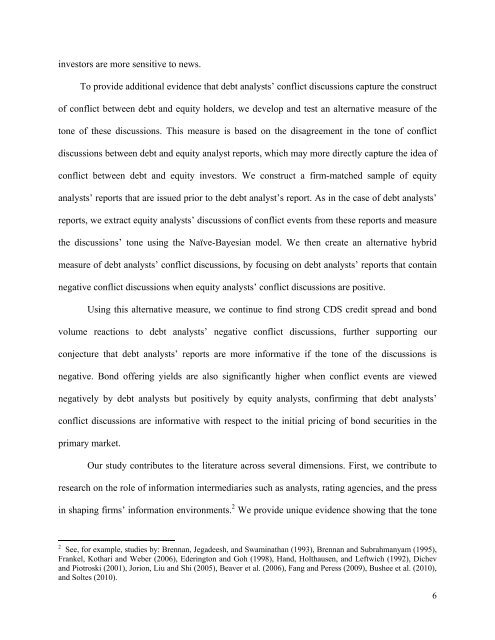Debt Analysts' Views of Debt-Equity Conflicts of Interest
Debt Analysts' Views of Debt-Equity Conflicts of Interest
Debt Analysts' Views of Debt-Equity Conflicts of Interest
Create successful ePaper yourself
Turn your PDF publications into a flip-book with our unique Google optimized e-Paper software.
investors are more sensitive to news.<br />
To provide additional evidence that debt analysts’ conflict discussions capture the construct<br />
<strong>of</strong> conflict between debt and equity holders, we develop and test an alternative measure <strong>of</strong> the<br />
tone <strong>of</strong> these discussions. This measure is based on the disagreement in the tone <strong>of</strong> conflict<br />
discussions between debt and equity analyst reports, which may more directly capture the idea <strong>of</strong><br />
conflict between debt and equity investors. We construct a firm-matched sample <strong>of</strong> equity<br />
analysts’ reports that are issued prior to the debt analyst’s report. As in the case <strong>of</strong> debt analysts’<br />
reports, we extract equity analysts’ discussions <strong>of</strong> conflict events from these reports and measure<br />
the discussions’ tone using the Naïve-Bayesian model. We then create an alternative hybrid<br />
measure <strong>of</strong> debt analysts’ conflict discussions, by focusing on debt analysts’ reports that contain<br />
negative conflict discussions when equity analysts’ conflict discussions are positive.<br />
Using this alternative measure, we continue to find strong CDS credit spread and bond<br />
volume reactions to debt analysts’ negative conflict discussions, further supporting our<br />
conjecture that debt analysts’ reports are more informative if the tone <strong>of</strong> the discussions is<br />
negative. Bond <strong>of</strong>fering yields are also significantly higher when conflict events are viewed<br />
negatively by debt analysts but positively by equity analysts, confirming that debt analysts’<br />
conflict discussions are informative with respect to the initial pricing <strong>of</strong> bond securities in the<br />
primary market.<br />
Our study contributes to the literature across several dimensions. First, we contribute to<br />
research on the role <strong>of</strong> information intermediaries such as analysts, rating agencies, and the press<br />
in shaping firms’ information environments. 2 We provide unique evidence showing that the tone<br />
2 See, for example, studies by: Brennan, Jegadeesh, and Swaminathan (1993), Brennan and Subrahmanyam (1995),<br />
Frankel, Kothari and Weber (2006), Ederington and Goh (1998), Hand, Holthausen, and Leftwich (1992), Dichev<br />
and Piotroski (2001), Jorion, Liu and Shi (2005), Beaver et al. (2006), Fang and Peress (2009), Bushee et al. (2010),<br />
and Soltes (2010).<br />
6
















